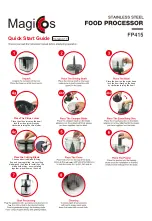
JTAG Port
TAP Controller
MOTOROLA
DSP56309UM/D 11-9
¥ Controlling the direction of bidirectional signals
¥ Controlling the output drive of tri-stateable output signals
For more details on the function and use of the EXTEST instruction, please refer to the
IEEE 1149.1 document.
11.3.2.2
SAMPLE/PRELOAD (B[3:0] = 0001)
The SAMPLE/PRELOAD instruction provides two separate functions. First, it provides
a means to obtain a snapshot of system data and control signals. The snapshot occurs on
the rising edge of TCK in the Capture-DR controller state. The data can be observed by
shifting it transparently through the BSR.
Note:
Because there is no internal synchronization between the JTAG clock (TCK)
and the system clock (CLK), the user must provide some form of external
synchronization to achieve meaningful results.
The second function of the SAMPLE/PRELOAD instruction is to initialize the BSR
output cells prior to selection of EXTEST. This initialization insures that known data
appears on the outputs when entering the EXTEST instruction.
11.3.2.3
IDCODE (B[3:0] = 0010)
The IDCODE instruction selects the ID register. This instruction is provided as a public
instruction to allow the manufacturer, part number, and version of a component to be
determined through the TAP.
shows the ID register configuration.
One application of the ID register is to distinguish the manufacturer(s) of components on
a board when multiple sourcing is used. As more components emerge which conform to
the IEEE 1149.1 standard, it is desirable to allow for a system diagnostic controller unit to
blindly interrogate a board design in order to determine the type of each component in
Figure 11-4
JTAG ID Register
0
1
11
12
27
28
31
0 0 1 0
1
0 0 0 0 0 0 0 1 1 1 0
Design
Core
Number
Chip
Derivative
Number
21
22
16
17
0 0 0 0 0
0 0 0 1 1 0
Center
Number
0 0 0 1 0
Manufacturer
Identity
Version
Information
Customer Part Number
1
AA0718
Summary of Contents for DSP56309
Page 25: ...xxii DSP56309UM D MOTOROLA Figure D 25 Port E Registers PCRE PRRE PDRE D 39 ...
Page 30: ...MOTOROLA DSP56309UM D 1 1 SECTION 1 DSP56309 OVERVIEW ...
Page 47: ...1 18 DSP56309UM D MOTOROLA DSP56309 Overview DSP56309 Architecture Overview ...
Page 48: ...MOTOROLA DSP56309UM D 2 1 SECTION 2 SIGNAL CONNECTION DESCRIPTIONS ...
Page 85: ...2 38 DSP56309UM D MOTOROLA Signal Connection Descriptions OnCE JTAG Interface ...
Page 86: ...MOTOROLA DSP56309UM D 3 1 SECTION 3 MEMORY CONFIGURATION ...
Page 104: ...MOTOROLA DSP56309UM D 4 1 SECTION 4 CORE CONFIGURATION ...
Page 124: ...MOTOROLA DSP56309UM D 5 1 SECTION 5 GENERAL PURPOSE I O ...
Page 125: ...5 2 DSP56309UM D MOTOROLA General Purpose I O 5 1 INTRODUCTION 5 3 5 2 PROGRAMMING MODEL 5 3 ...
Page 128: ...MOTOROLA DSP56309UM D 6 1 SECTION 6 HOST INTERFACE HI08 ...
Page 166: ...MOTOROLA DSP56309UM D 7 1 SECTION 7 ENHANCED SYNCHRONOUS SERIAL INTERFACE ESSI ...
Page 212: ...MOTOROLA DSP56309UM D 8 1 SECTION 8 SERIAL COMMUNICATION INTERFACE SCI ...
Page 241: ...8 30 DSP56309UM D MOTOROLA Serial Communication Interface SCI GPIO Signals and Registers ...
Page 242: ...MOTOROLA DSP56309UM D 9 1 SECTION 9 TRIPLE TIMER MODULE ...
Page 269: ...9 28 DSP56309UM D MOTOROLA Triple Timer Module Timer Operational Modes ...
Page 270: ...MOTOROLA DSP56309UM D 10 1 SECTION 10 ON CHIP EMULATION MODULE ...
Page 302: ...MOTOROLA DSP56309UM D 11 1 SECTION 11 JTAG PORT ...
Page 369: ...C 22 DSP56309UM D MOTOROLA DSP56309 BSDL Listing ...
Page 370: ...MOTOROLA DSP56309UM D D 1 APPENDIX D PROGRAMMING REFERENCE ...
Page 405: ......
Page 409: ......
















































